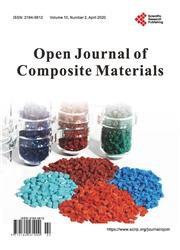Recipe Development and Mechanical Characterization of Carbon Fibre Reinforced Recycled Polypropylene 3D Printing Filament
引用次数: 8
Abstract
Recycled polypropylene filaments for fused filament fabrication were investigated with and without 14 wt% short fibre carbon reinforcements. The microstructure and mechanical properties of the filaments and 3D printed specimens were characterized using scanning electron microscopy and standard tensile testing. It was observed that recycled polypropylene filaments with 14 wt% short carbon fibre reinforcement contained pores that were dispersed throughout the microstructure of the filament. A two-stage filament extrusion process was observed to improve the spatial distribution of carbon fibre reinforcement but did not reduce the pores. Recycled polypropylene filaments without reinforcement extruded at high screw speeds above 20 rpm contained a centreline cavity but no spatially distributed pores. However, this cavity is eliminated when extrusion is carried out at screw speeds below 20 rpm. For 3D printed specimens, interlayer cavities were observed larger for specimens printed from 14 wt% carbon fibre reinforced recycled polypropylene than those printed from unreinforced filaments. The values of tensile strength for the filaments were 21.82 MPa and 24.22 MPa, which reduced to 19.72 MPa and 22.70 MPa, respectively, for 3D printed samples using the filaments. Likewise, the young’s modulus of the filaments was 1208.6 MPa and 1412.7 MPa, which reduced to 961.5 MPa and 1352.3 MPa, respectively, for the 3D printed samples. The percentage elongation at failure for the recycled polypropylene filament was 9.83% but reduced to 3.84% for the samples printed with 14 wt% carbon fiber reinforced polypropylene filaments whose elongation to failure was 6.58%. The SEM observations on the fractured tensile test samples showed interlayer gaps between the printed and the adjacent raster layers. These gaps accounted for the reduction in the mechanical properties of the printed parts.碳纤维增强再生聚丙烯3D打印丝的配方开发及力学性能研究
研究了在含有和不含有14wt%短纤维碳增强体的情况下用于熔融丝制造的回收聚丙烯丝。使用扫描电子显微镜和标准拉伸试验对细丝和3D打印样品的微观结构和力学性能进行了表征。观察到具有14wt%短碳纤维增强的回收聚丙烯长丝包含分散在长丝的整个微观结构中的孔。观察到两阶段长丝挤出工艺可以改善碳纤维增强体的空间分布,但不会减少孔隙。在高于20rpm的高螺杆速度下挤出的没有增强的回收聚丙烯长丝包含中心线空腔,但没有空间分布的孔。然而,当在低于20rpm的螺杆速度下进行挤出时,该空腔被消除。对于3D打印的样品,观察到用14wt%碳纤维增强的再生聚丙烯打印的样品的层间空腔比用未增强的细丝打印的样品大。细丝的拉伸强度值为21.82MPa和24.22MPa,对于使用细丝的3D打印样品,其分别降低到19.72MPa和22.70MPa。同样,对于3D打印的样品,细丝的杨氏模量分别为1208.6MPa和1412.7MPa,分别降至961.5MPa和1352.3MPa。再生聚丙烯长丝的断裂伸长率为9.83%,但用14wt%碳纤维增强聚丙烯长丝印刷的试样的断裂伸长率降至3.84%,其断裂伸长率为6.58%。对断裂拉伸试样的SEM观察显示,印刷层和相邻光栅层之间存在层间间隙。这些间隙是印刷零件机械性能降低的原因。
本文章由计算机程序翻译,如有差异,请以英文原文为准。
求助全文
约1分钟内获得全文
求助全文

 求助内容:
求助内容: 应助结果提醒方式:
应助结果提醒方式:


